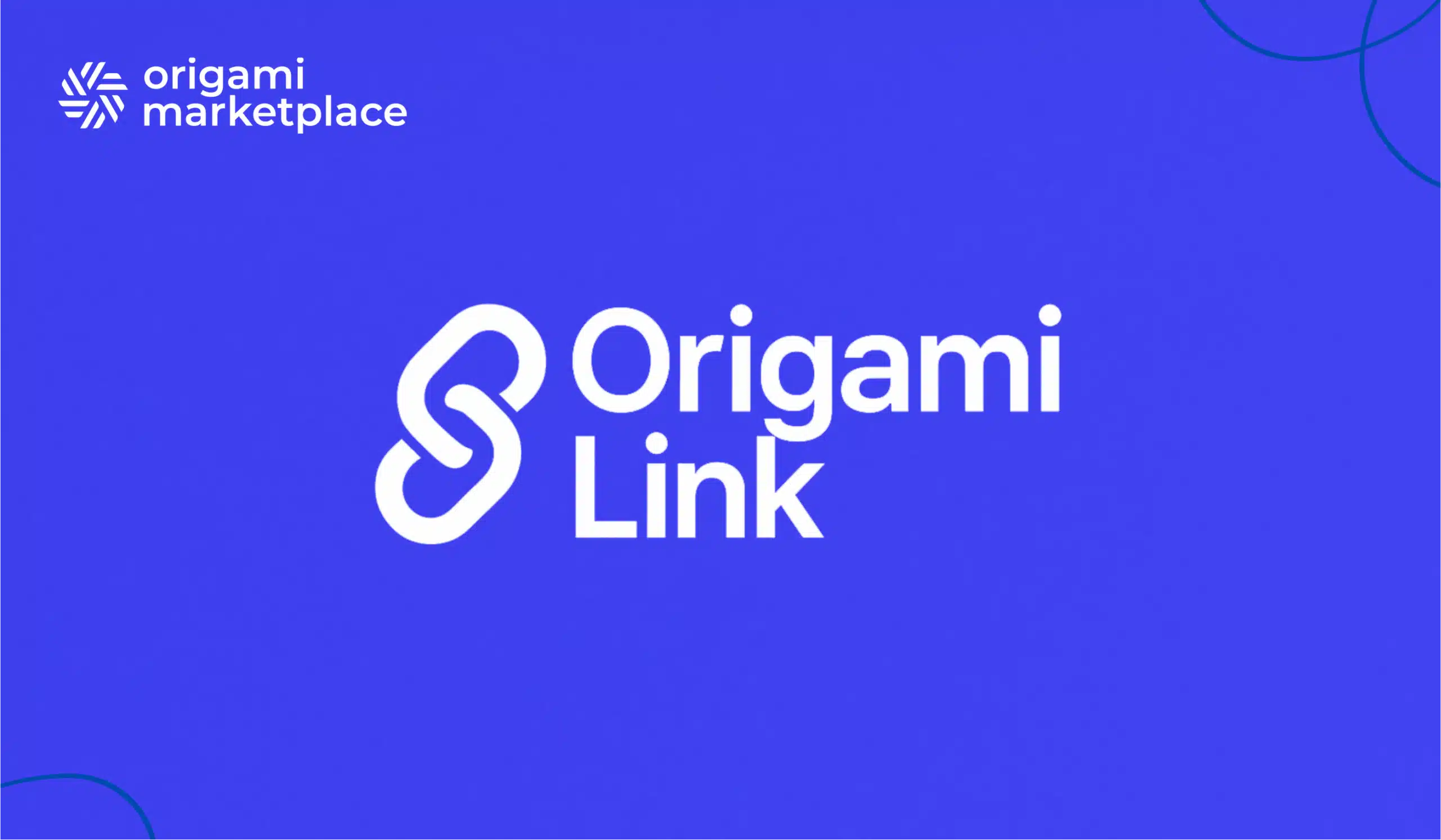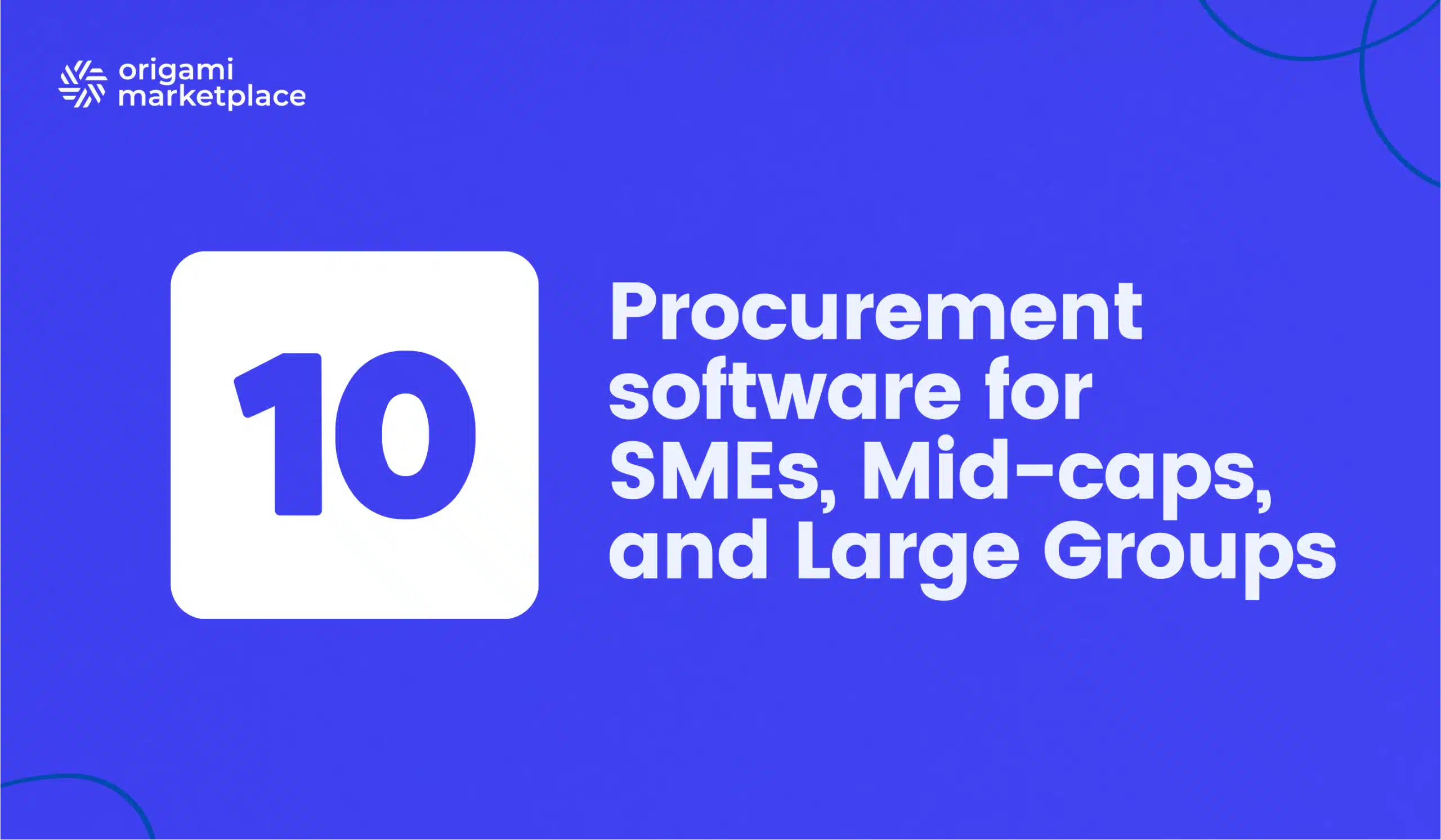Procurement automation: moving from traditional procurement to a marketplace approach.
- Emeline Kerloch
- 9 minutes de lecture
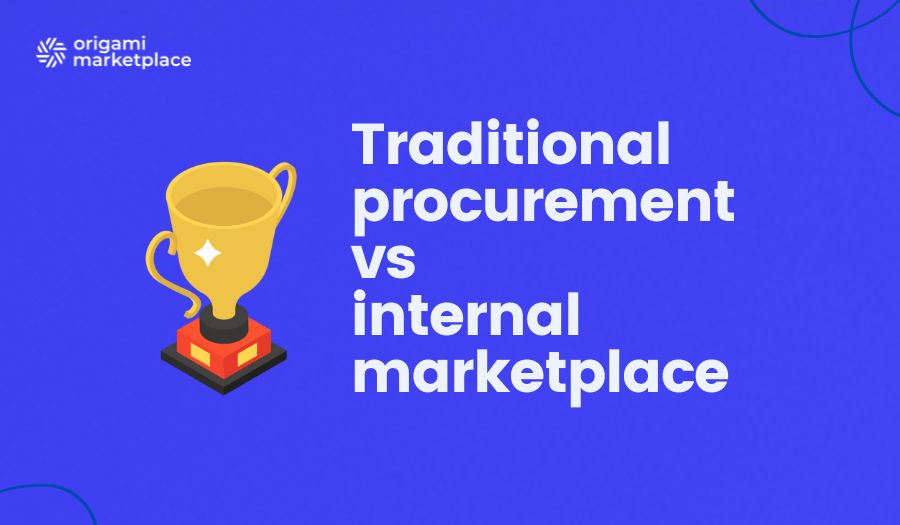
The procurement function is at a strategic turning point. The long-standing pressure to reduce costs is now inextricably linked to the need for agility and resilience, as well as an improved user experience to encourage the adoption of tools. Performance is now measured in terms of not only savings achieved, but also operational efficiency and employee satisfaction. In order to analyse this transformation, this article will first explore the foundations of traditional procurement, its contributions, and its limitations. It will then introduce the procurement marketplace paradigm as a response to these constraints by conducting a strategic comparison between the two models. Finally, it will propose a roadmap for implementing such a platform and look ahead to a future of intelligent, sustainable and predictive procurement.
- E-procurement: the foundation of digitisation in the purchasing process
- The rise of the B2B marketplace: a revolution inspired by B2C
- Strategic confrontation: traditional procurement vs. the procurement marketplace
- Launching your procurement marketplace: roadmap and key success factors
- The future of procurement: towards a smart, sustainable and predictive marketplace
I. E-procurement: the foundation of digitisation in the purchasing process
In order to understand the revolution brought about by the marketplace approach, it is important to grasp the fundamentals and limitations of its predecessor: traditional e-procurement. Although this first generation of tools laid the foundations for digitalisation, its control-focused design revealed flaws that made evolution inevitable.
1. The promise of the automated Procure-to-Pay (P2P) cycle
E-procurement involves the digitisation of purchasing processes between a company and its suppliers using online technologies. The aim is to establish a direct, paperless connection in order to manage purchases more quickly and efficiently. This concept forms part of the procure-to-pay (P2P) cycle, covering the entire procurement chain from supplier search to electronic invoicing.
Adopting these systems has generated quantifiable benefits:
- Reduced transaction costs: going digital can cut costs by up to 80% on order processing.
- Lower administrative costs: automation and paper elimination can reduce administrative costs by 30–35%.
- Purchasing gains: better negotiation and order rationalisation can deliver savings of between 5% and 45% on direct purchasing costs.
2. How does a traditional e-procurement system work?
The highly structured procurement process ensures compliance. Users can select products from pre-negotiated online catalogues or complete a form for “off-catalogue” requirements. This request then undergoes a validation process before the system generates and sends the purchase order to the supplier. Once received, the electronic invoice is matched to the order, prompting payment without the need for paper documents to be circulated”
3. The limitations of a rigid model: when the tool becomes an obstacle
Despite its success, the traditional model has shown its limitations, mainly due to its rigidity.
- Deploying a procurement solution is often a large, lengthy and costly project, requiring complex integration with existing systems such as ERP, and this can lead to complexity and implementation cost issues.
- User adoption is its greatest challenge. Interfaces are often considered complex and unintuitive, resulting in low adoption rates. Employees are accustomed to the fluidity of personal online shopping experiences and perceive the professional tool as an obstacle. A study showed that 68% of French employees using this software considered their IT department’s tools inadequate, leading them to use their own applications for business purchases.
- Traditional systems struggle to manage non-standard requirements, which reintroduces manual complexity and leads to maverick spending. This friction directly causes maverick spending. These purchases, made outside of approved channels, represent around 5% of the total purchase volume, yet generate 70% of processing costs. They can involve up to 75% of suppliers, which undermines consolidation efforts and creates compliance risks.
Although traditional procurement is designed to control spending, it ends up causing the behaviour it seeks to eliminate, and a significant portion of the gains are offset by the additional costs of uncontrolled spending.
II. The rise of the B2B marketplace: a revolution inspired by B2C
In the face of the limitations of traditional procurement, the procurement marketplace has emerged as a paradigm shift, bringing the user-centric approach and philosophy of B2C to meet the modern demands of choice, user experience and agility.
1. The "consumerisation" of professional procurement
The main driver of this transformation is ‘consumerisation’: consumer expectations are being transferred to the professional sphere. B2B buyers now expect a simplified, fast and personalised buying experience, rendering static catalogues and forms obsolete. This transition has been accelerated by the emergence of platforms, which give end buyers more autonomy and enable them to compare and order with just a few clicks.
2. The marketplace ecosystem: a tripartite model
The operation of a procurement marketplace relies on three key players.
- The operator, which is the company itself and defines the rules, qualifies suppliers, negotiates prices and runs the platform via its team of buyers.
- Sellers: suppliers who manage their own catalogues and process orders via the platform.
- Customers: employees who benefit from a single point of access to a wide range of pre-approved products, offering a user experience similar to B2C.
This model resolves the tension between freedom and control. By making the official channel more convenient and comprehensive than uncontrolled purchasing, the marketplace encourages compliance.
'The B2B marketplace is not just an evolution of traditional procurement — it's a Copernican revolution. We are transitioning from a rigid system centred on buyer control to a fluid platform centred on the user experience. By replicating the simplicity and functionality of B2C platforms, the internal marketplace connects employees with a network of verified suppliers, turning a complicated administrative task into a straightforward and user-friendly purchasing experience. Control does not disappear; it becomes invisible and contextual, integrated into an experience that naturally promotes adoption and compliance.'

Alexandre Duquenoy
Ready to turn your B2B, B2C, or C2C marketplace vision into reality?
To help you develop the best platform possible, we’ve gathered all the must-have features, key technical considerations, and best practices in a comprehensive document:
Download the Specifications template 🗒
Perfect for smaller or medium-scale projects without a formal purchasing process. It will help you outline your requirements effectively and streamline your selection process.
Download the Request for Proposal template 📒
Ideal for larger, more complex marketplace projects with a formal purchasing department or advanced procurement policies.
III. Strategic confrontation: traditional procurement vs. the procurement marketplace
A comparison of the two models reveals fundamental differences that explain why the marketplace is emerging as the new standard.
- User experience (UX): traditional procurement is process-oriented and complex, focusing on constraints. In contrast, the marketplace is user-centric and intuitive, inspired by B2C, and aims for natural adoption.
- Supplier diversity: traditional procurement streamlines and limits the number of suppliers. In contrast, the marketplace expands choice by facilitating the integration of hundreds of suppliers, including smaller ones, thereby creating healthy competition.
- Agility and flexibility: traditional procurement is often a monolithic, cumbersome application that evolves slowly. The marketplace enables rapid implementation and continuous evolution via APIs.
- Data richness: traditional procurement has a blind spot when it comes to maverick spending. The marketplace offers comprehensive visibility, capturing rich transactional and behavioural data to enable proactive management.
The prescriptive control of traditional procurement (“you must buy this”) is replaced by the contextual control of the marketplace (“you are free to choose from these approved options”).
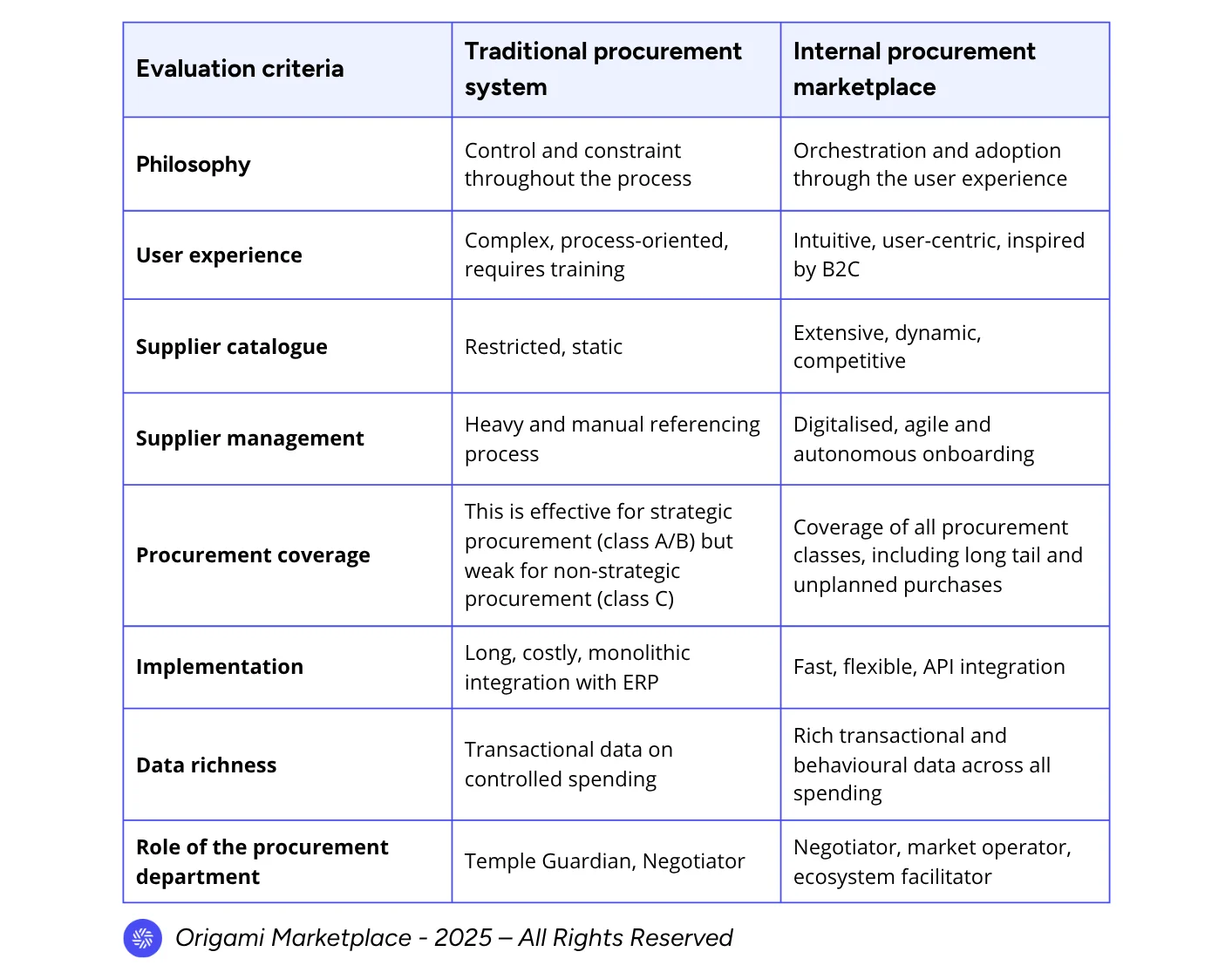
The return on investment for a marketplace is much broader. It incorporates the value derived from reduced maverick spending, increased efficiency and the market intelligence generated by comprehensive data.
IV. Launching your procurement marketplace: roadmap and key success factors
A rigorous methodology is required for the transition to a marketplace, which is a strategic transformation project.
1. Planning and technology
Rather than being a simple IT initiative, the project must be integrated into the company’s overall strategy. An audit of existing processes helps to identify bottlenecks and define the initial scope, which is often indirect purchases (class C), where quick gains can be made. The approach must be agile, beginning with a pilot project to test and demonstrate the value of the model. The choice of technology is critical: a Software as a Service (SaaS) solution should be preferred for its flexibility, API integration capabilities, and flawless user experience for both buyers and suppliers.
"The most common mistake is trying to do everything for everyone from day one. The success of a procurement marketplace is built iteratively. Our advice is to start 'on the periphery': target a category of non-strategic purchases that cause problems, or a subsidiary on a trial basis. Demonstrate value within this controlled scope, prove ROI by capturing uncontrolled purchases and turn your first users into your best ambassadors. Expansion will then happen naturally, driven by internal demand rather than solely by project management."

Antoine Mantel
2. Change management and adoption
Above all, success is a human endeavour. Strong sponsorship from management is required to overcome resistance. Involving all stakeholders (users, managers, the finance department and suppliers) in co-construction workshops is essential to ensure that the solution is appropriate and to turn them into ambassadors. A tailored communication and training plan is vital for explaining the benefits and ensuring adoption.
3. Pitfalls to avoid
There are several potential obstacles that could compromise the project:
- Neglecting supplier onboarding: for example, a marketplace without a wide range of offerings is useless. The seller integration process must be straightforward and proactive.
- Underestimating governance: clear rules must govern the operation of the platform (seller validation, dispute management, etc.).
- Focusing solely on technology: technology is a facilitator, not an end in itself. Processes and roles must be redefined in parallel.
- Lack of specificity: trying to cover everything from the outset is risky. It makes more sense to start with a well-defined segment, demonstrate success and then expand gradually.
V. The future of procurement: towards a smart, sustainable and predictive marketplace
The marketplace is a forward-thinking platform, ready to embrace the next wave of innovations that will transform the way we shop.
Artificial intelligence exponentially increases the platform’s value. By analysing behavioural data, it provides personalised recommendations, performs predictive supplier risk analysis and automates complex tasks using cognitive technology, freeing up buyers to focus on more strategic activities.
The marketplace is also becoming a powerful tool for CSR/ESG policy. It promotes responsible purchasing by integrating ESG criteria into supplier selection, such as labels and carbon footprint, and by encouraging the circular economy through refurbished products and local sourcing. It also simplifies non-financial reporting by centralising data.
This evolution is transforming the role of the buyer. They are shifting from the role of transactional negotiator to that of market operator and ecosystem facilitator. Free from repetitive tasks, buyers can focus on managing critical relationships, driving innovation, and aligning the purchasing strategy with the company’s objectives.
Ensure your success today. Take advantage of our free configurator to define the key outlines of your project and speak with one of our experts for a personalized study.
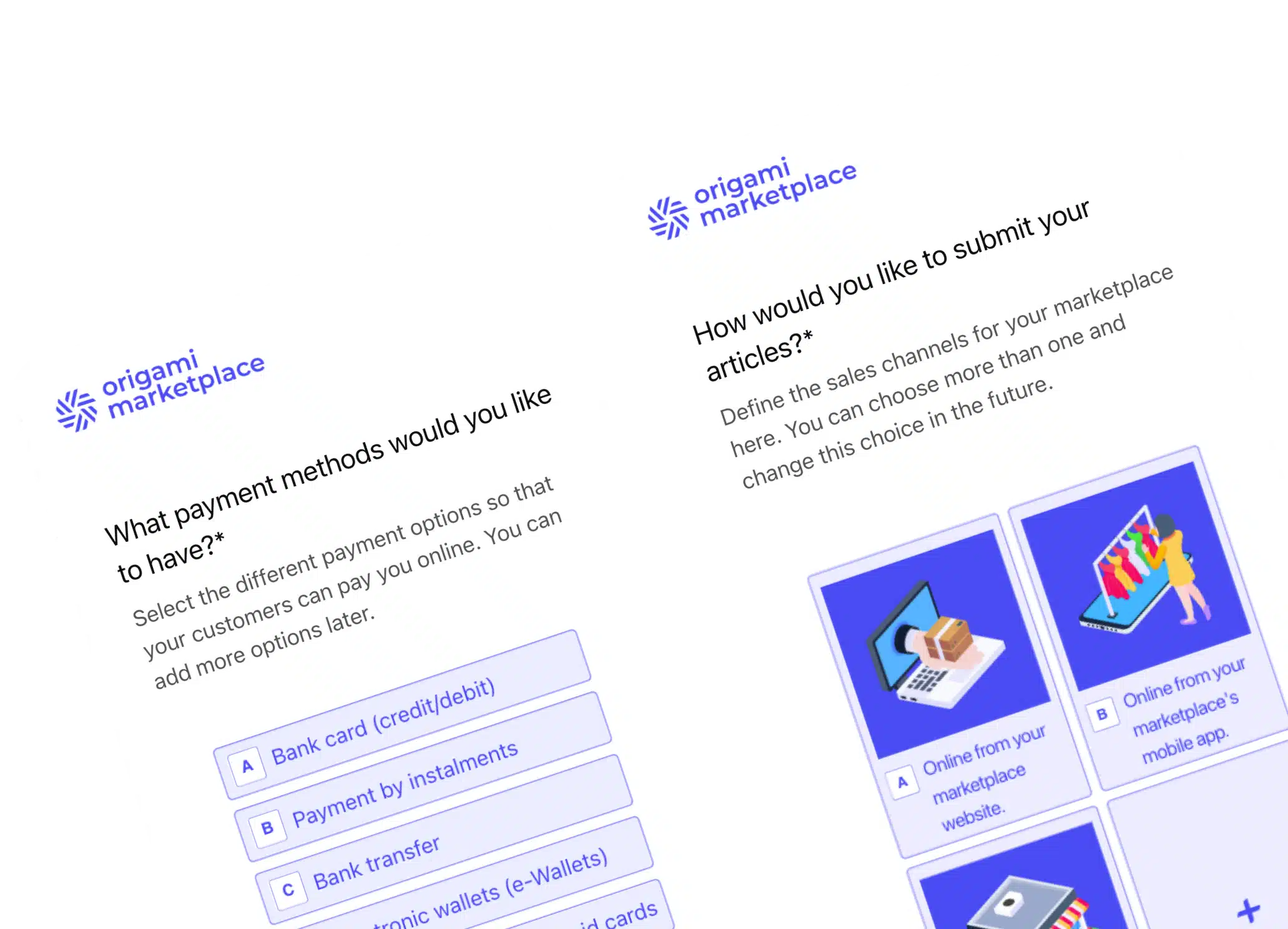
Conclusion: the marketplace is more than just a tool. It is a paradigm shift for the procurement function.
Although traditional procurement was a necessary step, its rigidity and poor user experience made change necessary. The internal procurement marketplace represents a paradigm shift. By combining user-friendly design with choice, agility and intelligent control, it transforms friction into fluidity and uncontrolled spending into strategic data.
This transition repositions the procurement function at the heart of the company’s strategy. Rather than being a cost centre focused on control, it becomes a business partner and ecosystem driver. By orchestrating its internal marketplace, the Procurement Department creates value, promotes innovation, improves resilience, and contributes directly to the organisation’s growth and sustainability objectives. This definitively affirms its role as a strategic value creator.
Don't have time to read everything? Get the key points in just 30 seconds!
Despite initiating the digitisation of purchasing, traditional procurement has reached its limits due to its rigidity, limited user experience, and inability to prevent costly ‘uncontrolled purchasing’. The internal procurement marketplace, inspired by the simplicity of B2C platforms, is changing the game. Offering an intuitive experience and a wide choice of pre-approved suppliers, it encourages employee adoption and transforms uncontrolled purchases into strategic data. This paradigm shift is transforming the procurement function from controller to agile market orchestrator, paving the way for a future where artificial intelligence and sustainability criteria (CSR/ESG) are at the heart of performance.
Ready to get started? Contact a specialist provider such as Origami Marketplace to speed up your project. Find out how our API and network of partners can transform your business, regardless of its size, with our innovative marketplace-based solution.

